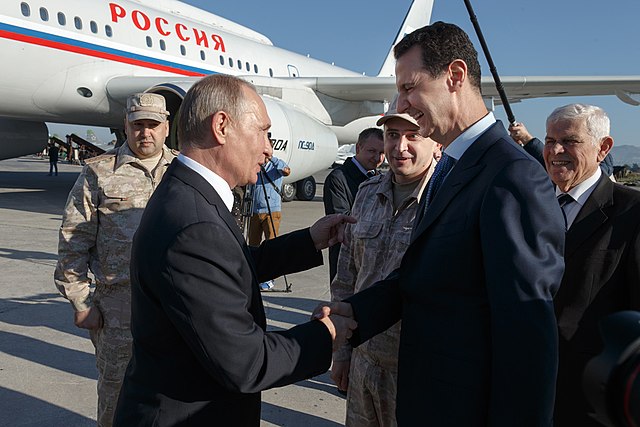
Much has been written about Russia’s ambitions in Syria and the Middle East, and there are numerous elements to Moscow’s strategy in the region. President Vladimir Putin has made clear his desire to restore Russia to great-power status and to build its profile as a global problem-solver. The Middle East offers him the opportunity to demonstrate Russia’s credentials.
Moscow’s foreign policy clearly reflects realist assumptions about the role of hard power as the defining feature of international politics. But such a broad characterisation does little to help illuminate Putin’s long-term ambitions in Syria and across the Middle East, the details of which remain obscure. There are also contradictions and a lack of clarity in Russia’s pattern of engagement in the region that likewise make it difficult to discern Russia’s objectives with any confidence.
Russia’s intervention in the Syrian civil war has been its most substantial recent foray into the Middle East. Moscow’s actions have been carefully calibrated and have tipped the balance in favour of Syria’s President Bashar al-Assad, but its motives for getting involved in the first place are complicated.
The original pretext was the targeting of Islamic State, but Moscow’s broader goal was to spoil Washington’s plans for regime change. Russia has also sought to present its actions in Syria as those of a mediator and peacebuilder, through its promotion of the 2017 Astana peace process.
Russia’s actions in Syria are part of a broader regional strategy that is both complex and fragile. Under Putin, Russia has sought to build ties with every state in the region, but has arguably prioritised countries closely aligned with the US—particularly Israel and Turkey—in order to undermine US interests in the region. Moscow’s decision to back Assad in Syria potentially prejudices Russia’s ongoing relations with traditional partners Israel, Turkey and Saudi Arabia, which seek to overthrow Assad and counter growing Iranian influence in the region.
The complex web of partnerships Russia has built in the Middle East equips it to play the role of mediator between regional adversaries. In mid-2018, Russia offered to broker an agreement between Israel and Iran that Iranian forces would remain a minimum of 100 kilometres from Israel. Russia has also negotiated multiple ceasefires in Syria, but has tended to adroitly use ceasefires to divide opposition groups and give the Assad regime breathing space to rebuild or refocus its forces.
Russia is also promoting itself as a mediator in other Middle East theatres, including in the conflict in Yemen, and appears determined to supplant the US as the principle negotiator in regional conflicts.
Looking beyond the façade of good global citizen that Putin is carefully crafting, it’s clear that Moscow’s primary motive is to advance its geopolitical ambitions. Following its Syrian intervention, Russia was awarded a 49-year deal for access to Syria’s Tartus naval base, Russia’s only base on the Mediterranean, and secured indefinite access to Syria’s Khmeimim air force base. Likewise, Russia’s mediation in the Yemen conflict occurred in the context of Moscow’s unfulfilled ambitions to secure rights to a naval base giving access to the Red Sea and the Horn of Africa. It is also pursuing access to military bases in Egypt, Libya and Sudan.
However, the web of relationships that Moscow is managing could unravel rapidly, with potentially disastrous consequences. Russia’s relationship with Turkey turned frosty in 2015 following the downing of a Russian jet by Turkish forces. Moscow responded by deploying air defence missile systems into northern Syria. Russian warplanes also bombed a Turkish aid convoy, and there was a real risk that the tensions would spiral into war.
Similarly, when a Russian military aircraft was recently shot down by Syrian forces targeting Israeli aircraft that were using the Russian aircraft as a shield, Moscow reacted by blaming Israel and supplying Syria with advanced air defence systems, dramatically increasing Syria’s capacity to target Israeli aircraft.
Such events test Russia’s capacity to sustain the competing bilateral relationships that underpin its Middle East strategy. Moscow’s posture has been helped by the fact that its intervention in Syria has to date been relatively low-cost in both manpower and munitions. But Putin and his inner circle likely remain mindful of the US’s disastrous interventions in Afghanistan and Iraq and will be careful to avoid escalation.
Russia has similarly been wary of committing to reconstruction plans, and has sought to diffuse responsibility for post-war planning and reconstruction to regional partners. Moscow unsuccessfully approached European countries to share the cost of reconstruction in Syria, estimated at US$250 billion, and the fact that it followed its requests with a veiled threat of continued refugee flows from Syria to Europe spoke volumes about its playbook.
It’s also not clear whether Russia is seeking a definitive end to the civil war. As demonstrated in Transnistria, South Ossetia, Abkhazia and eastern Ukraine, Russia prefers to freeze conflicts rather than resolve them, as this provides it with additional levers with which it can sustain its influence and interests.
And herein lies the problem sitting at the heart of Russia’s Middle East strategy—Putin’s posturing and efforts to portray Russia as a constructive actor in Middle East peace sit at odds with the hard realist core of Russia’s ambitions in the region. Russia also appears to be as much motivated by a desire to subvert US and European interests as it is interested in establishing a network of client states and military bases across the region.
So far, Russia’s regional partners have played along with this charade, and Russia has also managed to deflect the true costs of the Syrian conflict. But over time, the risk of Russia being called out on its actions will increase, and as noted elsewhere, it will then learn that it is easier to get involved in a war than to get out of one.

